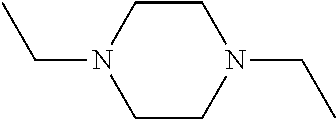Glucagon analogues
a technology of glucagon and analogues, applied in the field of glucagon analogues, can solve the problems of obesity and life expectancy reduction, glp-1 on the other hand is not capable of activating glucagon receptors, etc., and achieve the effects of inhibiting or reducing, preventing weight gain, and promoting weight loss
- Summary
- Abstract
- Description
- Claims
- Application Information
AI Technical Summary
Benefits of technology
Problems solved by technology
Method used
Image
Examples
example 1
General Synthesis of Glucagon Analogues
[0153]Solid phase peptide synthesis (SPPS) was performed on a microwave assisted synthesizer using standard Fmoc strategy in NMP on a polystyrene resin (TentaGel S Ram). HATU was used as coupling reagent together with DIPEA as base. Piperidine (20% in NMP) was used for deprotection. Pseudoprolines: Fmoc-Phe-Thr(psiMe,Mepro)-OH and Fmoc-Asp-Ser(psiMe,Mepro)-OH (purchased from NovaBiochem) were used where applicable.
[0154]Abbreviations employed are as follows:[0155]Boc: tert-butyloxycarbonyl[0156]ivDde: 1-(4,4-dimethyl-2,6-dioxocyclohexylidene)3-methyl-butyl[0157]Dde: 1-(4,4-dimethyl-2,6-dioxocyclohexylidene)-ethyl[0158]DCM: dichloromethane[0159]DMF: N,N-dimethylformamide[0160]DIPEA: diisopropylethylamine[0161]EDT: 1,2-ethanedithiol[0162]EtOH: ethanol[0163]Et2O: diethyl ether[0164]HATU: N—[(dimethylamino)-1H-1,2,3-triazol[4,5-b]pyridine-1-ylmethylene]-N-methylmethanaminium hexafluorophosphate N-oxide[0165]MeCN: acetonitrile[0166]NMP: N-methylpyrr...
example 2
General Synthesis of Acylated Glucagon Analogues
[0171]The peptide backbone was synthesized as described above for the general synthesis of glucagon analogues, with the exception that it was acylated on the side chain of a lysine residue with the peptide still attached to the resin and fully protected on the side chain groups, except the epsilon-amine on the lysine to be acylated. The lysine to be acylated was incorporated with the use of Fmoc-Lys(ivDde)-OH or Fmoc-Lys(Dde)-OH. The N-terminus of the peptide was protected with a Boc group using Boc2O in NMP. While the peptide was still attached to the resin, the ivDde protecting group was selectively cleaved using 5% hydrazine hydrate in NMP. The unprotected lysine side chain was then first coupled with a spacer amino acid like Fmoc-Glu-OtBu, which was subsequently deprotected with piperidine and acylated with a fatty acid using standard peptide coupling methodology as described above. Alternatively, the histidine at the N-terminal ma...
example 3
Glucagon Receptor and GLP-1-Receptor Efficacy Assays
[0172]The cDNA encoding either the human glucagon receptor (Glucagon-R) (primary accession number P47871) or the human glucagon-like peptide 1 receptor (GLP-1R) (primary accession number P43220) were synthesized and cloned into a mammalian expression vector containing a Zeocin resistance marker.
[0173]The mammalian expression vectors encoding the Glucagon-R or the GLP-1-R were transfected into Chinese hamster ovary (CHO) cells by the Attractene method. Stably expressing clones were obtained by Zeocin selection (250 μg / mL) upon limited dilution of cells resistant to the selection pressure. Glucagon-R and GLP-1-R cell clones expressing were picked, propagated and tested in the Glucagon-R and GLP-1-R efficacy assays as described below. One Glucagon-R expressing clone and one GLP-1-R expressing clone were chosen for compound profiling.
[0174]CHO cells expressing the human Glucagon-R, or human GLP-1-R were seeded 24 hours prior to the ass...
PUM
| Property | Measurement | Unit |
|---|---|---|
| width | aaaaa | aaaaa |
| lipophilic | aaaaa | aaaaa |
| weight loss | aaaaa | aaaaa |
Abstract
Description
Claims
Application Information
 Login to View More
Login to View More - R&D
- Intellectual Property
- Life Sciences
- Materials
- Tech Scout
- Unparalleled Data Quality
- Higher Quality Content
- 60% Fewer Hallucinations
Browse by: Latest US Patents, China's latest patents, Technical Efficacy Thesaurus, Application Domain, Technology Topic, Popular Technical Reports.
© 2025 PatSnap. All rights reserved.Legal|Privacy policy|Modern Slavery Act Transparency Statement|Sitemap|About US| Contact US: help@patsnap.com



